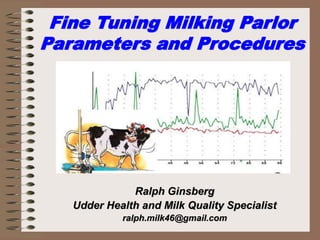This document discusses parameters and procedures for fine tuning a milking parlor. It provides details on the Israeli dairy herd, factors that affect milk secretion such as lactation number, climate, milking interval and frequency. Milking cows three times a day can increase milk production by 3-4 kg/cow/day compared to twice daily milking. More frequent milking for only 21 days at the start of lactation may produce carry-over effects and increase total lactation yield. Managing a dairy to milk cows four times per day presents logistical challenges and requires excellent management practices.








































